by gabriel_sales | Oct 4, 2012
B2B lead generation has changed more in the past 18 months than we have seen in the previous 12 years we have been providing outsourced b2b lead generation through sales lead scoring as an outsourced b2b lead generation company. One of the largest drivers is the simple fact that your buyers are answering the phone 50% less than they did 18 months ago. Across the board our calls to connect ratio (someone actually picking up the phone) has dropped from 15%-22% to 8%-12%. With all these changes, it’s critical that you maximize the result of every lead, which requires you do a better job of lead scoring.
This blog is part 1 of a 2 part series. Part 1 will address the basics of sales lead scoring to improve the performance of your sales and marketing b2b lead generation investment. Part 2 will introduce a lead scoring best practices framework to make your content marketing easier with a couple simple framework tips and some tool suggestions.
1. What is sales lead scoring?
Sales lead scoring is the ability to figure out where someone is in their buying process. It is a process that combines information gathered by you telemarketers through some basic qualifying questions with the type of content a buyer is consuming and creating a numerical value that ranks the buyers level of interest and their ability to transact with you (are they an influencer or can they sign the agreement?). Sales lead scoring allows sales and marketing to quickly flag who should go to higher end sales reps and who should not.
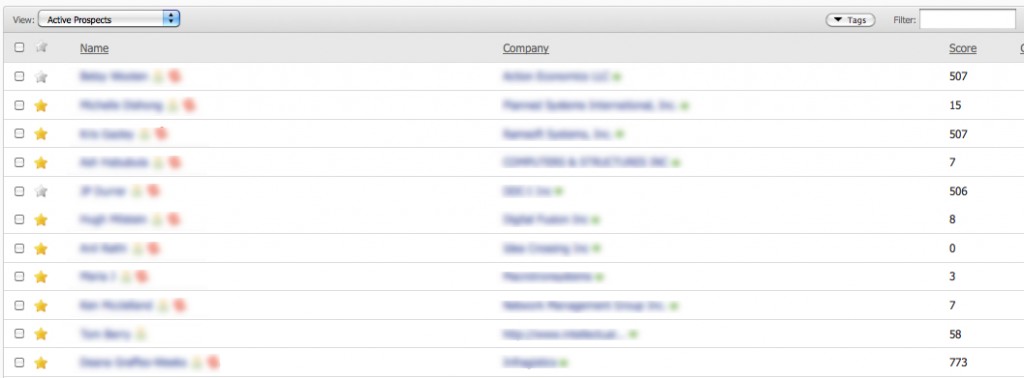
2. What is the first step in lead scoring?
It’s critical that everyone agrees on the “lead” definition. The more complex the sale is, the tougher this can be, especially if your sale requires someone on the buyer side to champion it through the organization or if the technical influencer takes the lead in the early buying process. The important thing is that there is agreement. And the most important person to get agreement from is your sales team There’s no point in your marketing team scoring leads alone because if sales does not agree with marketing on what a quality lead is there will be conflict and you are simply going to end up where you started.
3. Why do I need to score sales leads?
In a word: Money. Scoring sales leads will lead to more revenue because better leads (buyers ready for sales) will get to your sales team faster. Scoring leads will also save you money because leads that are not ready to buy can be managed by less expensive inside reps during the early education stages of your buying cycle or even better by your marketing team leveraging digital content in an automated process.
4. What Types of Data Do I Need to Score Leads?
Lead scoring is comprised of two parts: “direct” and “inferred” information; both types of information are important. Direct is gathered by your inside sales team when they pick up the phone and ask buyers questions and “Engage” them. It’s also gathered by keeping track of the title, business vertical and company size etc. Inferred information is gathered by keeping tracking of the type of content your buyer is consuming.
Direct Data – When your inside rep engages the buyer, he/she figures out if the leads is a fit. Does your your product meet a need? Does the buyer know their need? Can the buyer sign the check? Is the buyer an influencer or not? Is there a budget for the project or not? Also the rep can cover any gaps in the basic lead info that marketing did not collect like company size, industry segment, job title, and location.
Infered Data – Data gathered from the digital consumption of your content: number of pages visits, specific web pages visited, recency of response, email activity, social media activity, online event registrations or downloads.
Hopefully this blog was helpful in explaining the basics of sales lead scoring. In part 2 we will discuss what a solid lead scoring best practice process looks like and make some recommendations around how to frame your content and tools you can use to make your content work harder.
Learn how to build a powerful B2B lead generation system, integrating sales and marketing, by viewing our resource page here.
by gabriel_sales | Sep 29, 2012
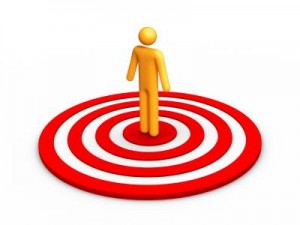 Best Practice for B2B Lead Generation – You Can’t Improve What You Don’t Measure
Best Practice for B2B Lead Generation – You Can’t Improve What You Don’t Measure
This blog will discuss a competitive advantage and a Best Practice for B2B Lead Generation for 2013. As a qualified sales lead generation company we were surprised how many B2B marketers still had a black box correlating b2b lead generation to sales return on investment. We will let the graphics below demonstrate how easy it could be for your business to gain a leg up on your competition by simply implementing a tool like Pardot in 2013 as a best practice for B2B lead Generation.
According to the 2nd annual Webmarketing123 State of Digital Marketing Survey (of over 500 U.S. marketing professionals) Search Engine Optimization (SEO), Pay Per Click Advertising (PPC), and Social Media Marketing
(SMM) are increasing in their level of adoption and spend. And spend is forecasted to continue to increase in 2013. The report when on to state:
- For B2B, lead generation is the top objective, and SEO is twice as effective as PPC or SMM for this purpose.
- Budgets: 90% of marketers will increase or maintain spending on SEO, PPC, and SMM.
- Still doing SEO in-house? Marketers using an agency are twice as likely to be highly satisfied with their campaign performance.
What we found surprising in the study are the statistics below:
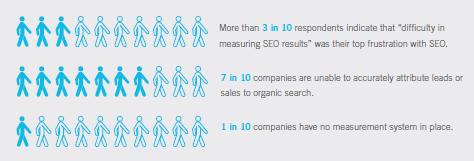
As an outsourced sales and marketing company we typically implement campaigns designed to generate leads through integrated email, SEO, PPC and cold calling campaigns. We then continue to nurture leads not ready to buy with a marketing automation platform like Pardot. An ancillary benefit of this approach is the transparency and ability to track leads directly through the pipe, for example specifically what tactics (like SEO) are doing for your revenue. Below is best practice for B2B lead generation in the form of two reports we typically leverage for both PPC and SEO on a monthly/weekly/daily basis so we can give your marketing efforts a sales quota tracking directly to the opportunity and then revenue level.


Hopefully a couple of pictures do paint a thousand words here. As we close 2012 and move to 2013 you need to ask yourself three questions around your b2b lead generation efforts.
- How do I improve what I don’t measure?
- If I do measure will it improve my performance?
- How much more revenue will I generate once I focus my marketing dollars on what’s producing?
Gabriel Sales provides b2b lead generation services and builds demand generation engines that integrate both sales reps, b2b lead gen, sales engagement and inbound marketing efforts. To see how we can help accelerate your production in this last quarter of 2012 so you hit the ground running in 2013 please feel free to contact us for a free benchmark review.
For additional info on marketing automation implementations, tips to improve the performance of your telesales team, your b2b lead generation or how to accelerate your content marketing efforts please feel free to check out the links below.
What is a Marketing Automation Platform? – 5 Minute Overview from Pardot
Selling Smarter and Selling Faster White Paper
by gabriel_sales | Sep 27, 2012
B2B Lead Generation Requires Content and Reps to Educate Your Buyers and Sales Reps to Engage Your Buyers
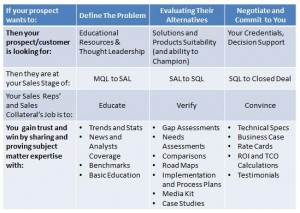 In Part 1 of this specific series on B2B lead generation we discussed how you can align your content marketing to educate buyers and your telesales reps to generate qualified leads and create demand for your product. In this blog we will discuss how as part of that process that is supporting your buyer’s needs you can also support your internal sales organization needs by engaging them in your sales process. In this blog we will discuss the questions your inside reps should be asking at specific stages of your B2B lead generation process to support your sales efforts.
In Part 1 of this specific series on B2B lead generation we discussed how you can align your content marketing to educate buyers and your telesales reps to generate qualified leads and create demand for your product. In this blog we will discuss how as part of that process that is supporting your buyer’s needs you can also support your internal sales organization needs by engaging them in your sales process. In this blog we will discuss the questions your inside reps should be asking at specific stages of your B2B lead generation process to support your sales efforts.
In a book way back from 2004 Think Like Your Customer, Bill Stinnett pointed out that “…your customers don’t buy solutions. They buy results.” Ultimately it’s your sales teams’ job to sell your buyer these results. While content marketing and your telesales team are building trust with your buyer your inside reps also need to be getting ready to “sell” results. Or more importantly setting up your closer to sell results. While your inside sales and/or telemarketing reps are helping your buyer become educated they should also be answering the following questions at the following stages:
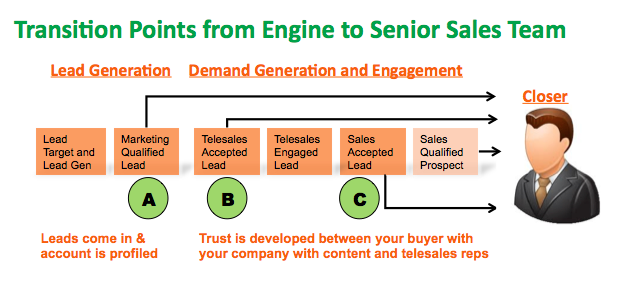
Stage A of B2B Lead Generation- Marketing Qualified Lead (MQL)
Typically your first touch you should be discovering:
- What is buyer’s urgency for getting educated right now?
- Is there an impending event?
Stage B of B2B Lead Generation – Telesales Accepted Lead
Typically your second live touch discovering:
- Who will be involved in the decision?
- How are decisions made?
- Who ultimately approves budget?
- What’s the real business motive for buying? Replace something? Cut costs? Increase topline?
- Who/what else are you considering?
- What are the consequences of doing nothing?
Moving From Stage B to Stage C of B2B Lead Generation
Typically buyer has stated they are not ready to talk to a senior rep yet. Your inside reps job is to start drilling down on how engagement will occur:
- Is there budget available? Does a case need to be made for budget?
- What is the impact, ROI or payback required?
- What is the risk associated with making a decision?
Content and marketing automation is great for education. It’s great for helping you to score where leads are in the buying cycle. The tactics are great for saving your reps time nurturing your pipe. But don’t confuse content consumption for engagement. Your investment in content marketing and thought leadership is a must but so are sales reps that are skilled in the science and art of making it easy for your buyers to both consume and engage. If you are not using telesales reps to ask these questions to help your buyers engage more deeply in your B2B lead generation process you are missing the boat. And if your buyer has digested 6- 8 pieces of content and they are not willing to engage and answer at least some of these questions then they are still educating and its more than fair for you to flat out ask what they “think the risk is in making the decision” and then feed them some content to help assuage that risk.
For more tips on how to align your sales and content marketing efforts around B2B lead generation feel free to check out our previous blog – B2B Demand Generation Requires Your Lead Gen Team to Pick Up the Phone, or Digital Content to Automate your Sale – A crash course in integrating sales and marketing efforts.
And feel free to contact us for a free benchmark review.
by gabriel_sales | Sep 24, 2012
B2B Demand Generation Requires More Than Just Content Marketing
This blog is part of our regular series of posts on what we have learned over the past several years, as an outsourced B2B demand generation company, to help to align sales and marketing. This first post will be part of a short two part series that frames what your content marketers can do to generate demand. And what your sales reps can do to get your buyers to engage.
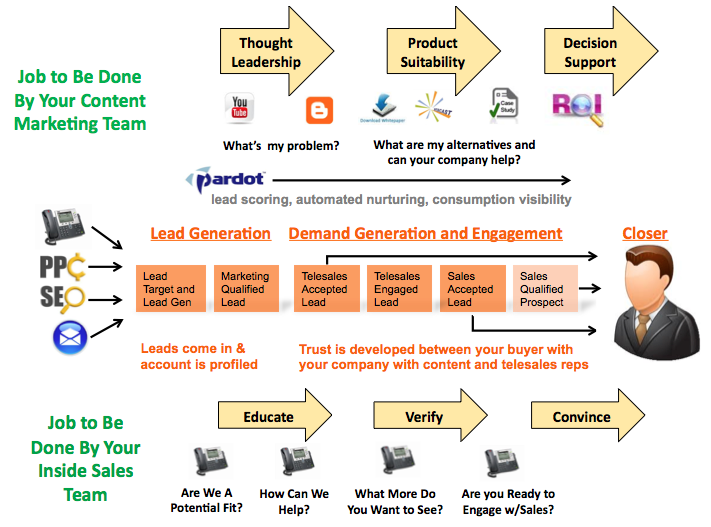
As an outsourced B2B demand generation company we are committed to marketing automation platforms and content marketing. Over the past year we have seen across clients a typical buyer consume 14 plus pieces of educational or verification content before they purchase. We believe Joe Pulizzi, author of Get Content, Get Customers that “The one who has the more engaging content wins, because frequent and regular contact builds a relationship because done correctly the content you create will position your company not as just a seller of stuff, but as a reliable source of information.” As a source of reliable information you will build trust. However that content and trust will only take you so far. At some point you need to take the buyers that are consuming your content, buyers that are developing trust, and get them to engage to increase that level of trust. And the best way to get them to engage is by picking up the phone and actually engaging them in helpful conversations.
Below is a quick framework of how you can align your content marketing with the efforts of your phone reps to support moving buyers deeper into the pipe.
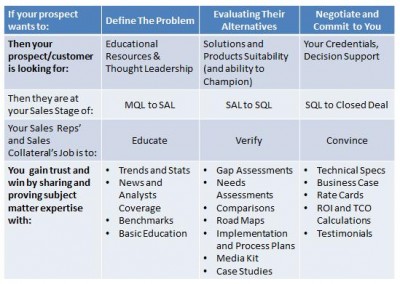
- When your buyers are early in the buying process they are trying to figure out what their problem is. Your job as a content marketer is to help them define their problem. The job of your inside rep is to help your buyer figure out if your company can even help and then share some additional content to help them define their problem a little more. Your telesales reps should not be ‘selling’ yet. They should be asking “how can we help”.
- At some point your buyer is going to have their problem framed. Ideally with the help of your content. At this point you need to “start engaging”. Don’t start selling yet. But you can start talking more about your solution specifically and move away from pure thought leadership. At this point your content marketers job is to be supplying your telesales engaged leads with content that allows them to share what other companies experience or have experienced with your company. Your content needs to start giving your buyer a sense of what it would be like to “own” your product or solution.
- Finally we move to a Sales Qualfied Lead. Your buyer is engaged and its time for content marketing and inside telesales reps to step out of the way and transition over to the closers.
This blog post has been written from the perspective of what you need to do to support your buyer. However its also important to support your sales effort. In Part 2 of this series we will discuss how you can use these early stages of telesales engagement to provide your closers with the information they need to:
- Understand where the buyer is in their buying cycle
- Capture information that allows your closer to do their job more effectively for your company and your buyer to make the final transaction as seamless and professional as possbile for your buyer and your senior sales executive so everyone wins.
To visit Part that discusses where to integrate your telesales reps CLICK HERE.
To see if Gabriel Sales outsourced B2B demand generation can help you close more business creating a seamless and aligned sales and marketing process that sells to your buyer the way they want to buy please feel free to contact us for a free benchmark review.
by gabriel_sales | Sep 21, 2012
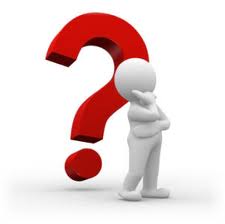 Outsourced Sales and Marketing can help you to achieve your sales targets faster and at a reduced operational cost. This is especially true if you are just getting out of the gate. In a previous blog we discussed the time and money it can save you in recruiting, sales management and marketing management. However you cannot expect to under fund your sales and marketing efforts and still compete in the market. This is especially true if you are a young company, a technology start-up or new to the market. An outsourced sales and marketing solution has the advantages of a fully functioning organization that is already in motion but you need to consider your competition and understand that if there is competition in the market that you need to invest enough to allow your sales and marketing team the ability to compete and win.
Outsourced Sales and Marketing can help you to achieve your sales targets faster and at a reduced operational cost. This is especially true if you are just getting out of the gate. In a previous blog we discussed the time and money it can save you in recruiting, sales management and marketing management. However you cannot expect to under fund your sales and marketing efforts and still compete in the market. This is especially true if you are a young company, a technology start-up or new to the market. An outsourced sales and marketing solution has the advantages of a fully functioning organization that is already in motion but you need to consider your competition and understand that if there is competition in the market that you need to invest enough to allow your sales and marketing team the ability to compete and win.
Some Strategic Issues that Shape Successful Outsourced Sales and Marketing
Here are some of the areas you should expect your outsourced sales and marketing company to explore with you:
Market dynamics – What is your understanding of the market and selling dynamics of other companies – Do you understand your differentiators. What is your core value proposition? How deep is your understanding of the competitive landscape?
Do you have realistic goals – Do you have any existing conversion metrics and sales pipe history to support those goals? Is one of the top priorities of your sales and marketing outsourced vendor to help with this?
Key events in your sales cycle – What are the key events that occur during your customers buying cycle? What is your win loss ratio? Do you need your sales and marketing outsourcing solution to help you figure this out. In that case you may want to position this as a consulting engagement to your board. If any of the past several issues has left you wondering what is the difference between outsourced sales vs. sales consulting here is a quick overview from a past blog post…Sales Consulting vs. Outsourced Sales.
What does your existing customer set look like – The prospects an outsourced sales and marketing company like Gabriel Sales will be targeting for you will want to understand who your current buyers are. Prospects will want to know what vertical markets you are in and you will need to be able to provide your outsourced sales partner with reference clients in other verticals if they are opening a new vertical or market for you.
Do you have the budget and the patience to successfully execute to a successful plan – While and outsourced sales and marketing company can get you into the market faster and more effectively, a well executed plan takes time to ramp. Obviously using an outsourced sales and marketing company will allow you to gain traction quickly but they will not be able to dramatically change a company’s typical buying cycle for your product. If your typical sales cycle takes 6-12 month you can expect an outsourced sales and marketing company to shave a month or two off that cycle at best but you need to account for the initial 90-120 days to ramp the initial pipe. Do you have the patience to wait for the sales engine to ramp? We typically see our efforts take significant hold at 9-12 months. We do have some tactics to gain traction with key accounts quickly. To help on this front you need to have an ideal customer profile but realistic timing needs to be factored into the overall strategy.
The right level of funding approved– All this boils down to the right level of funding. Sales and marketing outsourcing help get you out of the gate faster and cheaper but it does not absolve you from the need to fund your efforts at levels where you can compete. You need to make sure that senior management and your board are aware of this and do not set false expectations. As with any strategic initiative you need to have buy-in and appropriate funding from the senior management team, and sales and marketing outsourcing is no exception.
There are many strategic decisions that you need to consider in executing a successful sales and marketing strategy. This blog addresses a handful that we work through with you. For additional tactics we use to ensure your long term success we invite you to check out a couple of our education series here:
Selling Smarter and Selling Faster White Paper
Build a Successful B2B Sales and Marketing Engine – Educational Resources
For more information on how Gabriel Sales has helped dozens of companies enter a market successfully please feel free to contact for us an initial review.


 Best Practice for B2B Lead Generation – You Can’t Improve What You Don’t Measure
Best Practice for B2B Lead Generation – You Can’t Improve What You Don’t Measure


 In Part 1 of this specific series on
In Part 1 of this specific series on 


 Outsourced Sales and Marketing can help you to achieve your sales targets faster and at a reduced operational cost. This is especially true if you are just getting out of the gate. In a previous blog we discussed the time and money it can save you in recruiting, sales management and marketing management. However you cannot expect to under fund your sales and marketing efforts and still compete in the market. This is especially true if you are a young company, a technology start-up or new to the market. An outsourced sales and marketing solution has the advantages of a fully functioning organization that is already in motion but you need to consider your competition and understand that if there is competition in the market that you need to invest enough to allow your sales and marketing team the ability to compete and win.
Outsourced Sales and Marketing can help you to achieve your sales targets faster and at a reduced operational cost. This is especially true if you are just getting out of the gate. In a previous blog we discussed the time and money it can save you in recruiting, sales management and marketing management. However you cannot expect to under fund your sales and marketing efforts and still compete in the market. This is especially true if you are a young company, a technology start-up or new to the market. An outsourced sales and marketing solution has the advantages of a fully functioning organization that is already in motion but you need to consider your competition and understand that if there is competition in the market that you need to invest enough to allow your sales and marketing team the ability to compete and win.